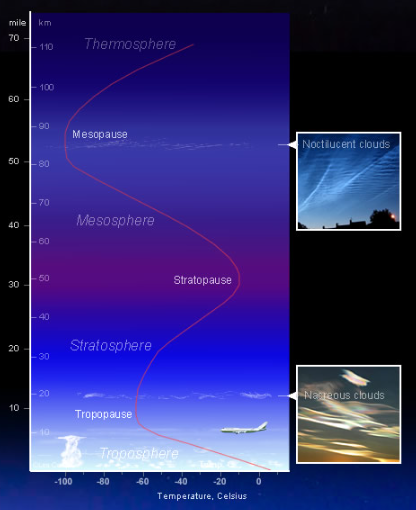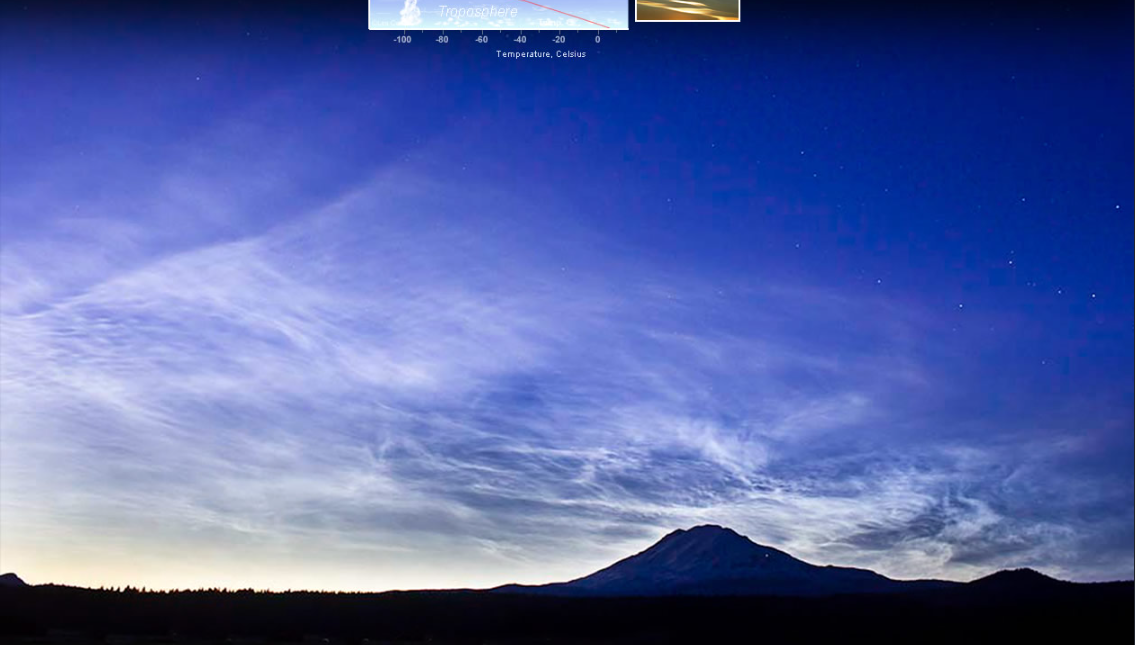OPOD - NLC season starts
OPOD - NLC Season Starts: A Spectacular Display of Earth's Highest Clouds
Noctilucent clouds (NLCs), also known as polar mesospheric clouds, are a stunning natural phenomenon that occurs during the summer months in the Northern Hemisphere. As we enter the month of May, it's time to start searching for these ethereal clouds that grace our skies. Captured in a breathtaking photograph by Darlisa Black of Starlisa Black Photography, these NLCs were spotted over Mount Adams in Washington, USA. With their distinctive appearance and mesmerizing glow, they never fail to captivate sky watchers around the world.
Where and When to Look for Noctilucent Clouds
The visibility window for NLCs extends from mid-May to mid-August in the Northern Hemisphere. While they are best observed at high latitudes between 50 and 65 degrees, they have increasingly been noticed further south. In fact, NLCs have been reported as far south as Utah and Colorado in the United States. To catch a glimpse of these elusive clouds, look towards the north in a sky free from light pollution. The optimal viewing time is approximately an hour after sunset or before sunrise.
Distinguishing Noctilucent Clouds from Other Cloud Types
Noctilucent clouds can be easily distinguished from lower tropospheric clouds by their unique characteristics. Unlike their darker counterparts, NLCs exhibit a much slower motion and possess a distinct skein-like structure. To enhance your observation experience, consider using binoculars to get a closer look at these extraordinary formations.
The Enigmatic Composition of Noctilucent Clouds
Noctilucent clouds are composed of incredibly small ice crystals that hover a few kilometers below the frigid mesopause. To form these clouds, temperatures below -123 degrees Celsius are required. It is this extreme cold that allows for the formation of ice crystals at such high altitudes. The mesmerizing glow of NLCs is a result of scattered sunlight at these lofty heights.
Noctilucent Clouds vs. Stratospheric Nacreous Clouds
While both noctilucent clouds and stratospheric nacreous clouds (also known as polar stratospheric clouds) grace our upper atmosphere, they possess distinct differences. The ice crystals in NLCs are much smaller compared to those in nacreous clouds, which prevents the production of colorful diffraction effects. As a result, NLCs exhibit a more subtle and ethereal appearance, often glowing in shades of silver and blue.
Witnessing the Spectacle of Noctilucent Clouds
The sight of noctilucent clouds in the night sky is truly a spectacle to behold. Their delicate and intricate formations create an otherworldly atmosphere, leaving observers in awe of nature's beauty. Whether you are an avid sky watcher or simply appreciate the wonders of our natural world, taking the time to search for and admire these elusive clouds is a rewarding experience.
A Reminder
Please note that this article has been automatically converted from the old website and may not appear as intended. To view the original article, you can visit this link.
So, as we embark on another NLC season, let us keep our eyes turned towards the northern horizon. With each passing night, there is a chance to witness the enigmatic dance of Earth's highest clouds. Don't miss out on the opportunity to marvel at the celestial beauty that noctilucent clouds bring to our summer skies.

Earth's Highest Clouds
Now is the time to start searching for noctilucent clouds. Darlisa Black (Starlisa Black Photography, atmos optics) captured these over Mount Adams, Washington, USA. ©Darlisa Black, shown with permission.
The NLC visibility window extends from mid May to mid August in the Northern Hemisphere. They are best seen at high latitudes of 50 - 65° but are increasingly noticed - as here - further south. In the U.S. they have been seen as far south as Utah and Colorado.
Look to the north in a non light polluted sky an hour or more after sunset or before sunrise.
They can be distinguished from lower (and dark) tropospheric clouds by their much slower motion and sharp skein-like structure. Binoculars help.

The clouds are composed of very small ice crystals floating a few km below the immensely cold mesopause. Temperatures below -123 Celsius are needed.
They shine by scattered high altitude sunlight.
Their crystals are much too small to produce the colourful diffraction effects of stratospheric nacreous clouds.

Note: this article has been automatically converted from the old site and may not appear as intended. You can find the original article here.
Reference Atmospheric Optics
If you use any of the definitions, information, or data presented on Atmospheric Optics, please copy the link or reference below to properly credit us as the reference source. Thank you!
-
<a href="https://atoptics.co.uk/blog/opod-nlc-season-starts/">OPOD - NLC season starts</a>
-
"OPOD - NLC season starts". Atmospheric Optics. Accessed on November 26, 2024. https://atoptics.co.uk/blog/opod-nlc-season-starts/.
-
"OPOD - NLC season starts". Atmospheric Optics, https://atoptics.co.uk/blog/opod-nlc-season-starts/. Accessed 26 November, 2024
-
OPOD - NLC season starts. Atmospheric Optics. Retrieved from https://atoptics.co.uk/blog/opod-nlc-season-starts/.